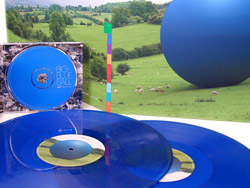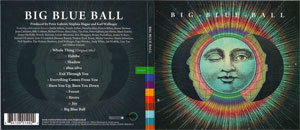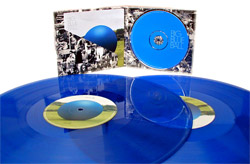- Article
- Read in 8 minutes
Peter Gabriel – Big Blue Ball – review
In the early 90s Peter Gabriel set up the RealWorld Recording Weeks where artists from all across the world would record music in a kind of “musical brainstorming”. One thing that came out of this is the album Big Blue Ball. It is not a Peter Gabriel album, but a collaboration project that took more than fifteen years to be released. Gabriel can be heard on four of the songs.
Big Blue Ball is the result of an international project set up and realized by Gabriel and Welsh musician Karl Wallinger (known from World Party and The Waterboys). In 1991, 1992 and 1995 Gabriel and Wallinger invited musicians, poets and songwriters from all corners of the Earth to come to Real World Studios for a week. The idea was that these artists from all the different cultural backgrounds would work together, play together, write songs and record them with each other. A body of music developed that brings together and combines all kinds of musical influences.
Peter Gabriel:„One week in the middle of summer this craziness exploded in our Real World Studios. We had this week of invited guests, people from all around the world, fed by music and a 24 hour café. It was a giant playpen, a bring your own studio party. There’d be a studio set up on the lawn, in the garage, in someone’s bedroom as well as the seven rooms we had available. We were curators of sorts of all this living mass. We had poets and songwriters there, people would come in and scribble things down, they’d hook up in the café. It was like a dating agency, then they’d disappear in the darkness and make noises – and we’d be there to record it.”

Unlike on other albums such as Passion or Ovo for which Gabriel also worked with many musicians from all over the world he is just one artist in many on this record. He plays on a mere five of the eleven pieces and sang on just three. On others he worked as a producer with Stephen Hague (known mainly as the producer of Erasure, OMD and the Pet Shop Boys) and Karl Wallinger.
From the multitude of songs that developed in these recording sessions a group of songs began to take shape that would make it onto the album. Not all the musicians who were involved in the sessions can actually be heard on the CD. A number of them have previously worked with Peter Gabriel: Sinéad O’Connor, Deep Forest, Papa Wemba and Hossam Ramzy. Some artists of Gabriel’s core band are also present, e.g. Ged Lynch, Manu Katche, Angie Pollock and Richard Evans.
The album could have been completed in 1995. Every now and then in the last fifteen years someone mentioned that it could be released. But Peter Gabriel is involved, of course, and that means that the clock tick in a different way – at least slower. The last overdubs and final recordings took place as late as 2007, but before we could give the Big Blue Ball a spin on our record tables another big blue ball had to circle the much larger yellow ball once more. Now the wait is finally over and Big Blue Ball has been released.
01 Whole Thing (Original Mix) 05:26
Peter Gabriel: lead vocals, keyboards
Karl Wallinger, Paul Allen: guitars
Francis Bebey: flutes
Alexis Faku: nord bass
Tim Finn, Andy White: backing vocals
Chuck Norman: programming
Tchad Blake: toms
The opening song of the album is a catchy tune that could be put out as a single. Peter’s voice hovers and rules over the arrangement of guitars and drums. After the first chorus guitars and drums move to the foreground, and they even begin to rock after the second chorus in a brief intermezzo. Peter’s doubled voice is particularly pleasant. You would not realize that Whole Thing was recorded in the early 90s. This rock guitar piece sounds very modern and would have fit Up better than Us.
02 Habibe 07:12
Natacha Atlas: vocals
Hossam Ramzy, Neil Sparkes: drums & percussion
The Hossam Ramzy Ramzy Egyptian Ensemle (Wael Abu Bakr, Adel Eskander, Momtaz Talaat): strings
Tim Whelan: saz
Stephen Hague: keyboards
Chuck Norman: programming

Whole Thing did not give away the fact that this song is much influenced by world music. Hossam Ramzy takes us straight into Arabian Nights with Habibe. This longest song on the album (seven minutes – at one point it was more than 20 minutes long) begins with Natacha’s intense voice accompanied by the saz, a Turkish lute. A dense carpet of sounds is woven supported by the strings, but after a minute or so it is torn up by forceful oriental rhythms. The groove gets you into a dancing mood. Western European ears will need some time to get used to it, but you will soon realize that this is quite a catchy tune in the line of, say, Sting’s Desert Rose or Tarkan’s Simarik, except Habibe is not as radio-friendly.
03 Shadow: 04:27
Papa Wemba: vocals
Reddi Amisi: backing vocals
Juan Cañizares: guitar
The Papa Wemba Band: percussion
Laurent Coatalen: bongos
Tchad Blake: frame drums
No, these are not the Gypsy Kings. This is Papa Wemba and band and Juan Cañizares playing the flamenco guitar. The voices of Papa Wemba and Reddi Amisi go very well together in this song where African influences and Latino sounds meld into a wonderful new thing. Even those of you who could sit still during Habibe will jump up to dance to this song. It is a fun song.
04 altus silva 06:07
Joseph Arthur, Iarla Ó Lionáird: vocals
Noel Ekwabi: bass
The Papa Wemba Band: conga
Eric Mouquet, Michael Sanchez: piano, keyboards
Vernon Reid: guitar synth
James McNally: whistle, low whistle
Ronan Browne: uilleann pipes
Chuck Norman: programming
Tchad blake: keyboards, harmonium and flute like body bells
Celtic sounds can sound fantastic when they are combined with African rhythms, as Afrocelt Sound System have shown us. Altus silva is no exception, but made even more palatable for the radio by the French techno duo Deep Forest. Joseph Arthur’s gentle voice floats over the piano riff and gives way to the Gaelic chorus of Afrocelt Sound System singer Iarla Ó Lionáird before they sing the closing section together. This is indeed a moment when two great voices meet. Irish flutes and a wavering bass complete a dreamy song.
05 Exit Through You 05:52
Joseph Arthur: vocals, guitar
Karl Wallinger: guitar, backing vocals
Peter Gabriel: vocals, bass, keyboards
Justin Adams: backing vocals
Chuck Norman: programming
Tchad Blake: shaker, tambourine, bass
Were it not for the slightly distorted voice of Joseph Arthur in the verses Exit For You could be a typical Gabriel song. There are characteristic keyboard sounds and programming effects that were used on Us and in part also on Up. The chorus sounds a bit like More Than This, with less guitar but more bass and rhythm. At the end there is some delicious Gabrielese. Arthur and Gabriel allegedly wrote this song in just one hour. If only our Peter would show a similar working speed now and then…
06 Everything Comes From You 04:42
Sinead O’Connor: vocals
Sevara Nazarkhan: backing vocals
Guo Youe: flutes
Joji Hirota: drums, percussion
Ged Lynch: drums
Rupert Hine: keyboards
Angie Pollock: piano
Richard Evans: guitar, mandolin and recorder
Everything Comes From You is the gloomiest and most melancholy song on an album that is quite happy overall. Sinéad O’Connor keeps repeating the same lines to the same piano melody, like a mantra. The sound structure of piano, flutes, mandoline and backing vocals grows more and more intense and threatening. This song is a big highlight on Big Blue Ball and belongs to the best I have ever heard by Sinéad.
07 Burn You Up, Burn You Down 04:30
Peter Gabriel: vocals, keyboards
The Holmes Brothers (Wendell Holmes, Sherman Holmes & Popsy Dixon), Juls Shear, Karl Wallinger: backing vocals
Justin Adams, David Rhodes: guitars
Jah Wobble, Wendy Melvoin: bass
Arona N’diaye: djembe, sabar
Billy Cobham: drums
Chuck Norman: programming
Tchad Blake: guitar synth, organ, skin shake, hi hat, frame drum
Another dance song. Burn You Up. Burn You Down was the party number on the Still Growing Up tour. At one point it was planned to be included on Up, but it would not have fit in there. This version is not too different from the 2003 single version. The Big Blue Ball version seems to be a bit slimmer and harder, and the vocals have moved to the fore. Personally, I like this a bit better than the 2003 version.
08 Forest 06:16
Hukwe Zawose: vocals
Vernon Reid: guitar
Arona N’diaye: percussion
Levon Minassian: doudouk
Chuck Norman, Stephen Hague: programming
Ethno sounds mingle with a stomping bass beat. Though it sounds like Deep Forest the two Frenchmen were not involved. One more can we hear the voice of the late Hukwe Zawose with whom Peter Gabriel had also worked on Animal Nation. Levon Minassian brings his doudouk, an instrument that added its special flavour to songs like Fourteen Black Paintings on Us. Add to that some rattling percussion by Arona N’diaye, some rhythm guitar and you get an agreeable ethno pop song. Nothing special, songs like this have been heard before, but it is a pleasant piece of music.
09 Rivers 05:44
Marta Sebestyen: lead vocals, flute
Karl Wallinger: bass
Vernon Reid: guitar synth
Stephen Hague: accordion
Chuck Norman: drones, river pad, general programming
Peter Gabriel: drones
This song is carried by Marta’s exotic voice alone. The keyboard textures and flute sounds mainly serve to support and enhance the mood. A song to sit back and relax.
10 Jijy 03:59
Rossy: vocals
Chuck Norman, Stephen Hague: programming
Arona N’diaye: percussion
Jah Wobble: bass
Here’s a rap song! Don’t worry, Gabriel did not invite any gangsta rappers to Real World studios. Rossy’s rap is melodic and friendly. Bass, percussion and the funky brass instruments also conspire to make this a fun song.
11 Big Blue Ball 04:50
Karl Wallinger: vocals, acoustic guitar, bass, keyboards
Peter Gabriel: piano, organ, keyboards, solo keyboards
Manu Katche: drums
Stephen Hague: accordion
Chuck Norman: programming
Tchad Blake: kick drum, bells
The final track is a bit calmer again. There are almost only acoustic instruments: accordion, acoustic guitars and organ. This song is so calm and relaxed that it could easily be on an Eric Clapton album, too. It is a bit folky and features a beautiful chorus that works very well with Karl Wallinger’s voice. You would never notice that Gabriel was involved with this song at all.

So, if you had hoped or feared for another Passion album you will be disappointed or relieved. Big Blue Ball is no inaccessible world music, but a collection of mainly catchy songs with world music influences. Though it has taken eighteen years from the first recordings to the release the album sounds very lively. Peter Gabriel managed to step back and resist the temptation to over-produce the material. The last time Gabriel decided to live with minor glitches and keep the album lively was in the early 80s. The outcome is a wonderful summer album bursting with joie de vivre. Though many different musical spheres collide with each other the album is very coherent. You can hear in every song how much fun the musicians had playing and participating in this project. It makes you wonder why it took almost two decades to complete the project. Big Blue Ball is not an album worth waiting this long for. But now that is has been released we really can enjoy it.
by Eric Engler
translated by Martin Klinkhardt

